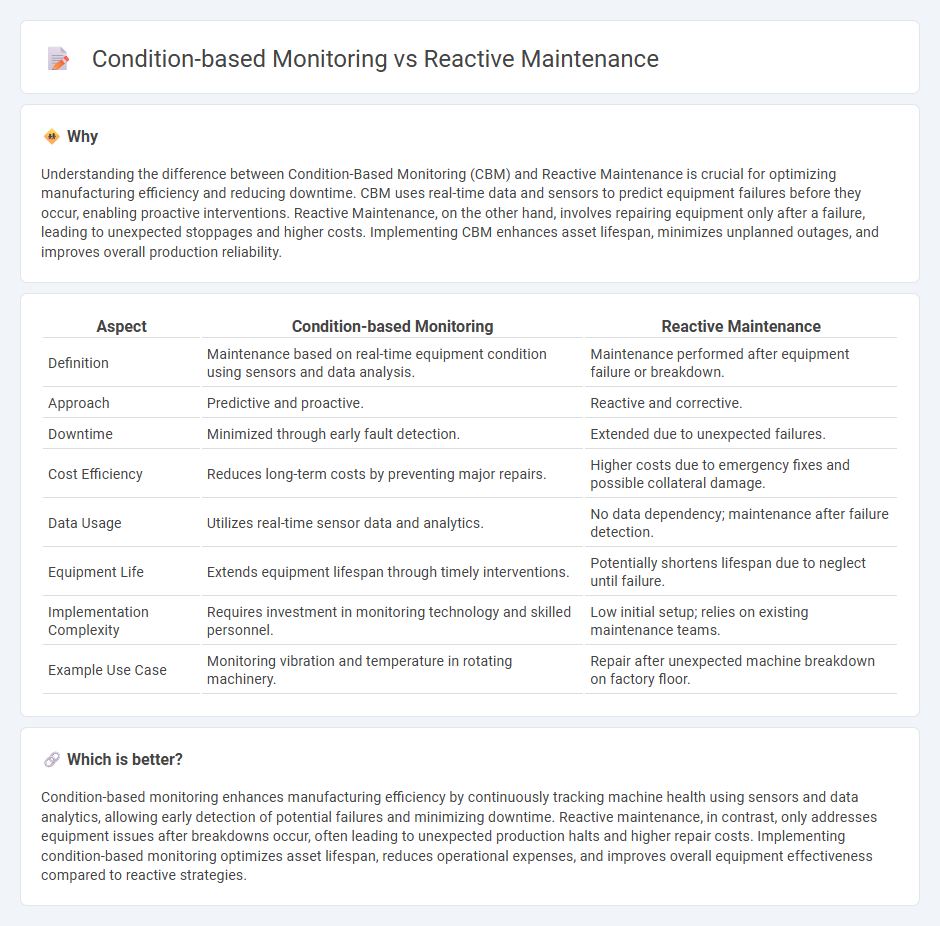
Condition-based monitoring uses real-time data and sensors to detect equipment anomalies, enabling proactive maintenance that minimizes downtime and extends machinery life. Reactive maintenance waits for equipment failure before addressing issues, often leading to costly repairs and production losses. Explore how adopting condition-based monitoring can transform your manufacturing maintenance strategy.
Why it is important
Understanding the difference between Condition-Based Monitoring (CBM) and Reactive Maintenance is crucial for optimizing manufacturing efficiency and reducing downtime. CBM uses real-time data and sensors to predict equipment failures before they occur, enabling proactive interventions. Reactive Maintenance, on the other hand, involves repairing equipment only after a failure, leading to unexpected stoppages and higher costs. Implementing CBM enhances asset lifespan, minimizes unplanned outages, and improves overall production reliability.
Comparison Table
| Aspect | Condition-based Monitoring | Reactive Maintenance |
|---|---|---|
| Definition | Maintenance based on real-time equipment condition using sensors and data analysis. | Maintenance performed after equipment failure or breakdown. |
| Approach | Predictive and proactive. | Reactive and corrective. |
| Downtime | Minimized through early fault detection. | Extended due to unexpected failures. |
| Cost Efficiency | Reduces long-term costs by preventing major repairs. | Higher costs due to emergency fixes and possible collateral damage. |
| Data Usage | Utilizes real-time sensor data and analytics. | No data dependency; maintenance after failure detection. |
| Equipment Life | Extends equipment lifespan through timely interventions. | Potentially shortens lifespan due to neglect until failure. |
| Implementation Complexity | Requires investment in monitoring technology and skilled personnel. | Low initial setup; relies on existing maintenance teams. |
| Example Use Case | Monitoring vibration and temperature in rotating machinery. | Repair after unexpected machine breakdown on factory floor. |
Which is better?
Condition-based monitoring enhances manufacturing efficiency by continuously tracking machine health using sensors and data analytics, allowing early detection of potential failures and minimizing downtime. Reactive maintenance, in contrast, only addresses equipment issues after breakdowns occur, often leading to unexpected production halts and higher repair costs. Implementing condition-based monitoring optimizes asset lifespan, reduces operational expenses, and improves overall equipment effectiveness compared to reactive strategies.
Connection
Condition-based monitoring utilizes real-time sensor data to track equipment health, enabling timely detection of anomalies and preventing unexpected breakdowns. Reactive maintenance is initiated only after a failure occurs, often resulting in higher downtime and repair costs. Integrating condition-based monitoring with reactive maintenance transforms unplanned repairs into more predictable interventions, optimizing asset lifespan and reducing overall operational expenses.
Key Terms
Equipment failure
Reactive maintenance involves addressing equipment failure only after it occurs, often resulting in unexpected downtime and higher repair costs. Condition-based monitoring uses real-time data from sensors to predict and prevent failures by monitoring equipment health, significantly reducing unplanned outages. Explore how integrating condition-based monitoring can enhance operational efficiency and minimize the risks of reactive maintenance failures.
Sensor data
Reactive maintenance relies on sensor data only after equipment failure occurs, leading to unplanned downtime and increased repair costs. Condition-based monitoring continuously analyzes real-time sensor data such as vibration, temperature, and pressure to predict potential failures and optimize maintenance schedules. Discover how integrating advanced sensor analytics transforms maintenance strategies for improved operational efficiency.
Predictive analytics
Reactive maintenance involves repairing equipment only after a failure occurs, leading to unplanned downtime and higher operational costs. Condition-based monitoring leverages sensors and real-time data to assess equipment health, enabling timely interventions before failures. Explore predictive analytics to enhance maintenance strategies and minimize unexpected outages.
Source and External Links
What is Reactive Maintenance? - IBM - Reactive maintenance, also known as corrective maintenance, is a strategy where repairs are performed only after an asset has failed, making it suitable for low-cost, non-critical assets that do not disrupt operations when they break down.
Reactive Maintenance | What is Reactive Maintenance? - UpKeep - Reactive maintenance involves repairing equipment after a breakdown or poor performance is observed, offering lower initial costs and reduced staffing needs, but it can lead to unplanned downtime and higher risks for critical machinery.
What Is Reactive Maintenance? | Learning Center - MaintainX - Often called "run-to-failure," reactive maintenance focuses on restoring assets quickly after they fail, and is best applied to non-critical, low-cost equipment with minimal impact on production or safety.
 dowidth.com
dowidth.com